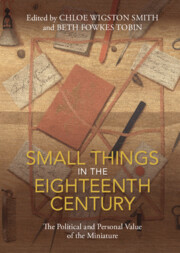Book contents
- Small Things in the Eighteenth Century
- Small Things in the Eighteenth Century
- Copyright page
- Contents
- Figures
- Notes on Contributors
- Acknowledgments
- Introduction
- Part I Reading Small Things
- Part II Small Things in Time and Space
- Part III Small Things at Hand
- 9 “We Bought a Guillotine Neatly Done in Bone”
- 10 “What Number?”
- 11 Two Men’s Leather Letter Cases
- 12 The Aesthetic of Smallness
- 13 “Small Gifts Foster Friendship”
- Part IV Small Things on the Move
- Afterword
- Select Bibliography
- Index
9 - “We Bought a Guillotine Neatly Done in Bone”
Illicit Industries on Board British Prison Hulks, 1775–1815
from Part III - Small Things at Hand
Published online by Cambridge University Press: 29 September 2022
- Small Things in the Eighteenth Century
- Small Things in the Eighteenth Century
- Copyright page
- Contents
- Figures
- Notes on Contributors
- Acknowledgments
- Introduction
- Part I Reading Small Things
- Part II Small Things in Time and Space
- Part III Small Things at Hand
- 9 “We Bought a Guillotine Neatly Done in Bone”
- 10 “What Number?”
- 11 Two Men’s Leather Letter Cases
- 12 The Aesthetic of Smallness
- 13 “Small Gifts Foster Friendship”
- Part IV Small Things on the Move
- Afterword
- Select Bibliography
- Index
Summary
Prisoner-made objects held immense monetary, national, and emotional value for their makers and consumers. In Britain and its colonies, partially dismantled wooden warships known as hulks were employed to ease prison overcrowding. Between 1775 and 1815, they housed both prisoners of war and convicts, often in neighboring ships. Although operating under different systems of administration, both types of prisoner crafted objects from whatever materials could be stolen, scavenged or bartered, and they concealed, smuggled, and hid them from authorities. This chapter begins by examining the intricate bone- and straw-work models made and traded by French prisoners of war, who altered their handicrafts to reflect shifts in consumer culture, before moving to focus on the personal and religious mementoes crafted by convicts in England and the penal colony of Bermuda, established in 1824. It concludes by illuminating the risks and rewards of illicit industries by considering the shared practices of gambling and forgery. This comparative chapter argues that the act of making – and selling – items provided both prisoners of war and convicts with the means to gain some small freedoms on board. Ultimately, it shows that objects of confinement represented sociability, human resilience, and adaptability in the face of hardship.
Keywords
- Type
- Chapter
- Information
- Small Things in the Eighteenth CenturyThe Political and Personal Value of the Miniature, pp. 143 - 157Publisher: Cambridge University PressPrint publication year: 2022

